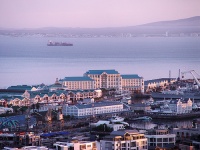 Getting Around Cape TownCape Town and its suburbs sprawl for miles, but with the ocean
and the dramatic landmarks of Table Mountain and Lions Head the
city is fairly easy to navigate. Most of the hotels are situated
along the Atlantic Seaboard. Public transport is poor and often
unsafe, so most visitors hire a car, particularly if planning
excursions from the city. To rent a car, drivers need to be over 23
years old and have a credit card and a full driving license (the
license must have a photo and be in English, otherwise an
International Driving Permit is required). Driving can be a
harrowing experience in Cape Town and lane changes confusing, with
signage often easy to miss, and the same road can change names
several times. For trips within the city or to the Atlantic beaches minibus
taxis are cheap and convenient and can be hailed by adventurous
travellers anywhere along their route, but the vehicles are often
in very bad condition and the driving can be appalling. Passengers
should expect to pay around R5 for most journeys within the city,
but are cautioned against getting into an empty minibus. Golden
Arrow buses leave from the main bus terminal to destinations around
the city; although timings can be erratic they can be a good option
for those on a budget. Tourists are advised to avoid the trains, with the exception of
the Simon''s Town line, which runs through the residential Southern
Suburbs, past Muizenberg and along the stunning False Bay coast.
Pick pocketing is rife, however, and there have been several
attacks on passengers. Rikkis, or small, open rickshaw type vehicles, are a novel way
to explore the city centre and Simon''s Town and are usually safe
and reliable. Taxis are expensive but are a good option at night
for those without a car. Public transport should not be taken after dark and the outlying
township areas should be avoided at all costs unless on an
organised tour. |